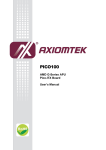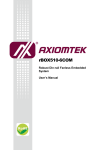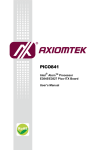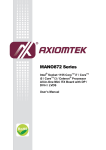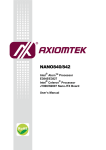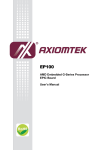Download EP830 User`s Manual VA1
Transcript
EP830 Series ® Intel Yonah & Merom CoreTM Duo and CoreTM Solo All-In-One EPIC SBC With DVI-I/LCD and EPIC Express User’s Manual Disclaimers This manual has been carefully checked and believed to contain accurate information. AXIOMTEK Co., Ltd. assumes no responsibility for any infringements of patents or any third party’s rights, and any liability arising from such use. AXIOMTEK does not warrant or assume any legal liability or responsibility for the accuracy, completeness or usefulness of any information in this document. AXIOMTEK does not make any commitment to update the information in this manual. AXIOMTEK reserves the right to change or revise this document and/or product at any time without notice. No part of this document may be reproduced, stored in a retrieval system, or transmitted, in any form or by any means, electronic, mechanical, photocopying, recording, or otherwise, without the prior written permission of AXIOMTEK Co., Ltd. CAUTION If you replace wrong batteries, it causes the danger of explosion. It is recommended by the manufacturer that you follow the manufacturer’s instructions to only replace the same or equivalent type of battery, and dispose of used ones. Copyright 2007 AXIOMTEK Co., Ltd. All Rights Reserved November 2007, Version A1 Printed in Taiwan ii ESD Precautions Computer boards have integrated circuits sensitive to static electricity. To prevent chipsets from electrostatic discharge damage, please take care of the following jobs with precautions: Do not remove boards or integrated circuits from their anti-static packaging until you are ready to install them. Before holding the board or integrated circuit, touch an unpainted portion of the system unit chassis for a few seconds. It discharges static electricity from your body. Wear a wrist-grounding strap, available from most electronic component stores, when handling boards and components. Trademarks Acknowledgments AXIOMTEK is a trademark of AXIOMTEK Co., Ltd. ® Windows is a trademark of Microsoft Corporation. Phoenix & AWARD are trademarks of Phoenix Technology Ltd. IBM, PC/AT, PS/2, VGA are trademarks of International Business Machines Corporation. ® ® Intel and Pentium are trademarks of Intel Corporation. Winbond is a trademark of Winbond Electronics Corp. Realtek is a trademark of Realtek Semi-Conductor Co., Ltd. Other brand names and trademarks are the properties and registered brands of their respective owners. iii Table of Contents Disclaimers ........................................................................................................... ii ESD Precautions ................................................................................................. iii Chapter 1 Introduction .................................................................... 1 1.1 1.2 Specifications .......................................................................................... 2 Utilities Supported ................................................................................... 4 Chapter 2 Jumpers and Connectors ............................................. 5 2.1 2.2 2.3 Board Layout and Fixing Holes ........................................................ 5 Board Dimensions ............................................................................ 7 Jumper Settings ............................................................................... 9 2.3.1 CompactFlash Mode Selection Jumper: JP1 ................................. 10 2.3.2 Power AT or ATX Selection Jumper: JP2 ...................................... 10 2.3.3 LVDS Voltage Selection Jumper: JP3........................................... 10 2.3.4 USB Voltage Selection Jumpers: JP4, JP7................................... 11 2.3.5 CMOS Clear Jumper: JP5............................................................. 11 2.3.6 CompactFlash Voltage Selection Jumper: JP6............................. 11 2.3.7 COM1 Mode Selection Jumpers: JP8, JP11, JP14........................ 12 2.3.8 COM1~4 Mode Selection Jumpers: JP9, JP10, JP12, JP13 ........ 13 2.3.9 Audio Line Out/Speaker Out Jumper: JP15 .................................. 17 2.4 Connectors ............................................................................................ 18 2.4.1 Power Control Connector: CN1...................................................... 19 2.4.2 EPIC EXPRESS Slot: CN2............................................................. 19 2.4.3 Power Output Connector: CN3....................................................... 20 2.4.4 LVDS Backlight Connector: CN4.................................................... 21 2.4.5 JST Connector for LVDS Flat Panel: CN5 ..................................... 21 2.4.6 SMBUS Connector: CN6................................................................ 22 2.4.7 IEEE 1394 Connectors: CN7/CN10 ............................................... 22 2.4.8 Flat Panel Bezel Connector: CN8 .................................................. 23 2.4.9 Audio Connector: CN9 ................................................................... 24 2.4.10 Digital I/O Port (DIO) Connector: CN11 ......................................... 24 2.4.11 LAN Connectors: CN12, LAN1, LAN2............................................ 24 2.4.12 Keyboard and PS/2 Mouse Connector: CN13................................ 26 2.4.13 +12V-IN Power Connector: ATX1 .................................................. 27 2.4.14 Serial Port Interface Connectors: COM1, COM2, COM3, COM4... 27 2.4.15 Digital Visual Interface (DVI) Connector: DVI1............................... 28 2.4.16 CPU & System Fan Connectors: FAN1, FAN2 .............................. 29 2.4.17 CompactFlash™ Socket: CFS1 ..................................................... 29 2.4.18 Parallel IDE Connector: IDE1......................................................... 30 2.4.19 USB Port Connector: USB1 ........................................................... 32 2.4.20 USB Connector: USB2 ................................................................... 32 2.4.21 SATA Connectors: SATA1, SATA2................................................ 33 iv Chapter 3 Hardware Description.................................................. 35 3.1 3.2 3.3 3.4 3.5 Microprocessors .................................................................................... 35 BIOS...................................................................................................... 35 System Memory..................................................................................... 35 I/O Port Address Map............................................................................ 36 Interrupt Controller ................................................................................ 37 Chapter 4 Award BIOS Utility ....................................................... 39 4.1 4.2 4.3 4.4 4.5 4.6 4.7 4.8 4.9 4.10 4.11 4.12 4.13 4.14 4.15 Entering Setup....................................................................................... 39 Control Keys .......................................................................................... 40 Getting Help .......................................................................................... 40 The Main Menu ..................................................................................... 41 Standard CMOS Setup Menu................................................................ 42 Advanced BIOS Features...................................................................... 45 Advanced Chipset Features .................................................................. 50 Integrated Peripherals ........................................................................... 53 Power Management Setup.................................................................... 58 PnP/PCI Configuration Setup................................................................ 62 PC Health Status................................................................................... 64 Load Optimized Defaults ....................................................................... 65 Set Supervisor/User Password ............................................................. 66 Save & Exit Setup ................................................................................. 67 Exit Without Saving ............................................................................... 68 Appendix A Watchdog Timer ....................................................... 69 Appendix B Digital I/O ................................................................... 71 v MEMO vi EP830 All-In-One EPIC Board User’s Manual Chapter 1 Introduction The All-In-One EPIC board EP830 Series supports Socket M (478) ® for Intel Yonah & Merom Core TM Duo and Core TM Solo processors ® with FSB533/667MHz. The board integrates Intel 945GME and ICH*7M chipsets that support one 200-pin DDR2 SDRAM with maximum 2GB system memory, DVI-I interface for both CRT and DVI external display devices, dual Gigabit /optional Fast Ethernet via PCIExpress x1 and AC'97 Codec Audio all in one single board. Additionally, it provides you with unique embedded features, such as 4 serial COM ports (RS-232), 4 USB2.0 ports for high speed peripherals, 2 IEEE 1394a ports and PCI Express expansion. It can achieve the best stability and reliability that makes your system perform the most endurable operation in any critical environments. The built-in Watchdog Timer has enhanced the system reliability that achieves a unique feature to distinguish itself from other boards. Designed for the professional embedded developers, the Socket M (478) embedded board EP830 Series is virtually ultimate one-step solution for embedded system applications. Introduction 1 EP830 All-In-One EPIC Board User’s Manual 1.1 Specifications ® CPU: Socket M (478) for Intel Yonach & Merom Core TM and Core Solo processors CPU Frequency: FSB533/667MHz System Chipset: Intel 945GME and ICH*7M BIOS TM Duo ® Phoenix-Award BIOS, Y2K compliant 4Mbit Flash, DMI, Plug and Play PXE Ethernet Boot ROM SmartView for multiple LCD type selection, display mode option and application extension features RPL/PXE Ethernet Boot ROM “Load Optimized Default” customized Setting in the BIOS flash chip to prevent from CMOS battery fail System Memory One x 200-pin DDR2 SODIMM socket Maximum to 2GB DDR2 memory L2 Cache: integrated in CPU Onboard IDE One PATA-100 with 44-pin 2.0 pitch box-header Two SATA-150 connectors Two IEEE 1394a ports CompactFlash Socket One CompactFlash Type II Socket Onboard Multi-I/O 4 COM ports (RS-232) USB Interface Four USB ports with fuse protection and complies with USB Spec. Rev. 2.0 Watchdog Timer 1~255 seconds; up to 255 levels 2 Introduction EP830 All-In-One EPIC Board User’s Manual Graphics 1 * CRT output @ rear I/O together with DVI output via CH7307 through SDVO-B 1 * 40-pin JST (SHDR-40V-S-B ) connector for dual channel LVDS from LFP port and 1 * 7-pin inverter connector Expansion Interface EPIC Express socket supported Ethernet 2 * RTL8111B (RTL8111C co-layout for FE), 10/100/1000 Base-T via PCI-Expres X1 2 single deck RJ-45 Audio AC’97 codec audio Line-in, Line-out and MIC-in, Power Management ACPI (Advanced Configuration and Power Interface) Form Factor EPIC form factor NOTE: All specifications and images are subject to change without notice. Introduction 3 EP830 All-In-One EPIC Board User’s Manual 1.2 Utilities Supported Chipset Driver VGA Driver Ethernet Driver Audio Driver 4 Introduction EP830 All-In-One EPIC Board User’s Manual Chapter 2 Jumpers and Connectors 2.1 Board Layout and Fixing Holes Component Side Jumpers and Connectors 5 EP830 All-In-One EPIC Board User’s Manual Solder Side 6 Jumpers and Connectors EP830 All-In-One EPIC Board User’s Manual 2.2 Board Dimensions Component Side Jumpers and Connectors 7 EP830 All-In-One EPIC Board User’s Manual Solder Side 8 Jumpers and Connectors EP830 All-In-One EPIC Board User’s Manual 2.3 Jumper Settings Proper jumer settings configure the EP830 to meet your application purpose. We are herewith listing a summary table of all jumpers and default settings for onboard devices, respectively. Here is a list of jumper settings: Jumper JP1 JP2 JP3 JP4 JP5 JP6 JP7 JP8 JP11 JP14 JP12 JP9 JP10 JP13 JP15 Default Setting CompactFlash Mode Selection : Slave Power AT or ATX Select :ATX LVDS Voltage select : 3.3V USB2 Voltage select : 5V Clear CMOS Setting : Normal Compact Flash Power Select : 3.3V USB1 Voltage select : 5V COM1 Mode Select: RS-232 COM1 Mode Select: RS-232 COM1 Mode Select: RS-232 COM1 Mode COM1 Pin 1: DCD Select COM1 Pin 9: RI COM2 Mode COM2 Pin 1: DCD Select COM2 Pin 8: RI COM3 Mode COM3 Pin 1: DCD Select COM3 Pin 8: RI COM4 Mode COM4 Pin 1: DCD Select COM4 Pin 8: RI Audio Line Out/Speaker Out: Line Out Jumpers and Connectors Jumper Setting Short 1-2 Short 1-2 Short 1-2 Short 2-3 Short 1-2 Short 1-2 Short 2-3 Short 3-5, 4-6 Short 3-5, 4-6 Short 1-2 Short 7-9 Short 8-10 Short 7-9 Short 8-10 Short 7-9 Short 8-10 Short 7-9 Short 8-10 Short 1-3, 2-4 9 EP830 All-In-One EPIC Board User’s Manual 2.3.1 CompactFlash Mode Selection Jumper: JP1 Description CompactFlash Mode Selection 2.3.2 Function Jumper Setting Slave (Default) JP1 Master JP1 Power AT or ATX Selection Jumper: JP2 This jumper let you select either AT or ATX power supply. Description Power Supply Selection 2.3.3 Function Jumper Setting ATX POWER (Default) JP2 AT POWER JP2 LVDS Voltage Selection Jumper: JP3 This jumper is to select the voltage for LVDS interface. Description LVDS Voltage Selection 10 Function Jumper Setting 3.3V (Default) JP3 5V JP3 Jumpers and Connectors EP830 All-In-One EPIC Board User’s Manual 2.3.4 USB Voltage Selection Jumpers: JP4, JP7 This jumper is to select the voltage for USB interface. Description USB Voltage Selection 2.3.5 Function Jumper Setting 5V_SBY JP4/JP7 5V (Default) JP4/JP7 CMOS Clear Jumper: JP5 You may need to use this jumper is to clear the CMOS memory if incorrect settings in the Setup Utility. Description CMOS Clear 2.3.6 Function Jumper Setting Normal (Default) JP5 Clear CMOS JP5 CompactFlash Voltage Selection Jumper: JP6 This jumper is to select the voltage for CompactFlash interface. Description Function CompactFlash 3.3V (Default) Voltage Selection 5V Jumpers and Connectors Jumper Setting JP6 JP6 11 EP830 All-In-One EPIC Board User’s Manual 2.3.7 COM1 Mode Selection Jumpers: JP8, JP11, JP14 These jumpers select the COM1 port’s communication mode to operate RS-232 or RS-422/485. Description Function COM1 12 Jumper Setting RS-232 (Default) JP14 JP8 JP11 RS-422 JP14 JP8 JP11 RS-485 JP14 JP8 JP11 Jumpers and Connectors EP830 All-In-One EPIC Board User’s Manual 2.3.8 COM1~4 Mode Selection Jumpers: JP9, JP10, JP12, JP13 These jumpers select the COM1, COM2, COM3, COM4 ports’ DCD and RI mode. Description COM1 Function Jumper Setting Pin 1=12V Pin 1=5V JP12 JP12 JP12 *Pin 1=DCD (Default) JP12 Pin 9=12V JP12 Pin 9=5V *Pin 9=RI (Default) Jumpers and Connectors JP12 JP12 JP12 13 EP830 All-In-One EPIC Board User’s Manual Description COM2 Function Pin 1=12V Pin 1=5V JP9 JP9 JP9 *Pin 1=DCD (Default) JP9 Pin 8=12V JP9 Pin 8=5V *Pin 8=RI (Default) 14 Jumper Setting JP9 JP9 JP9 Jumpers and Connectors EP830 All-In-One EPIC Board User’s Manual Description COM3 Function Jumper Setting Pin 1=12V Pin 1=5V JP10 JP10 JP10 *Pin 1=DCD (Default) JP10 Pin 8=12V JP10 Pin 8=5V *Pin 8=RI (Default) Jumpers and Connectors JP10 JP10 JP10 15 EP830 All-In-One EPIC Board User’s Manual Description COM4 Function Pin 1=12V Pin 1=5V JP13 JP13 JP13 *Pin 1=DCD (Default) JP13 Pin 8=12V JP13 Pin 8=5V *Pin 8=RI (Default) 16 Jumper Setting JP13 JP13 JP13 Jumpers and Connectors EP830 All-In-One EPIC Board User’s Manual 2.3.9 Audio Line Out/Speaker Out Jumper: JP15 Description Audio Line Out/ Speaker Out Function Jumper Setting Line Out (Default) JP15 Speak Out JP15 Jumpers and Connectors 17 EP830 All-In-One EPIC Board User’s Manual 2.4 Connectors Connectors connect the CPU card with other parts of the system. Loose or improper connection might cause problems. Make sure all connectors are properly and firmly connected. Here is a summary table shows you all connectors on the EP830 Series. Connectors Label Power Control Connector EPIC EXPRESS Slot Power Output Connector LVDS Backlight Connector LVDS1 Connector SM BUS Connector IEEE1394a Connector Front Panel Bezel Connector Audio Connector IEEE1394a Connector Digital I/O Connector LAN2 Connector (Optional) 6-Pin Mini Dim Keyboard / Mouse Connector +12V-IN Power Connector Serial Port1 Connector Serial Port2 Connector Serial Port3 Connector Serial Port4 Connector CompactFlash™ Socket DDRII SO-DIMM Digital Visual Interface (DVI) Connector CPU FAN Connector System FAN Connector Parallel IDE Connector LAN1 Connector LAN2 Connector USB Port0 & Port1 Connector USB Port2 & Port3 Connector SATA Connector SATA Connector 18 CN1 CN2 CN3 CN4 CN5 CN6 CN7 CN8 CN9 CN10 CN11 CN12 CN13 ATX1 COM1 COM2 COM3 COM4 CFS1 DIMMS1 DVI1 FAN1 FAN2 IDE1 LAN1 LAN2 USB1 USB2 SATA1 SATA2 Jumpers and Connectors EP830 All-In-One EPIC Board User’s Manual 2.4.1 Power Control Connector: CN1 Pin 2.4.2 Description 1 PWR_PSON- 2 GND CN1 EPIC EXPRESS Slot: CN2 2 120 1 11 9 Pin 1 3 7 9 13 15 19 21 25 27 31 33 37 39 41 43 47 49 53 55 59 61 65 67 Description A_PE_TXP_0 A_PE_TXN_0 B_PE_TXP_0 B_PE_TXN_0 C_PE_TXP_0 C_PE_TXN_0 D_PE_TXP_0 D_PE_TXN_0 PERST+3.3V_SBY +5V +5V +5V +5V +5V +5V +5V +5V +5V +5V +5V +5V RESERVED RESERVED Jumpers and Connectors Pin 2 4 8 10 14 16 20 22 26 28 32 34 34 40 42 44 48 50 54 56 60 62 66 68 Description A_PE_RXP_0 A_PE_RXN_0 B_PE_RXP_0 B_PE_RXN_0 C_PE_RXP_0 C_PE_RXN_0 D_PE_RXP_0 D_PE_RXN_0 A_CLKP A_CLKN B_CLKP B_CLKN C_CLKP C_CLKN D_CLKP D_CLKN +12V -12V E_CLKP E_CLKN F_CLKP F_CLKN E_PE_TXP_0 E_PE_TXN_0 19 EP830 All-In-One EPIC Board User’s Manual Pin 71 73 77 79 81 83 87 89 93 95 99 101 105 107 111 113 117 119 Description RESERVED RESERVED RESERVED RESERVED RESERVED RESERVED F_PE_RXN_3 F_PE_RXP_3 E_PE_RXN_3 E_PE_RXP_3 F_PE_TXN_3 F_PE_TXP_3 E_PE_TXN_3 E_PE_TXP_3 F_PE_RXP_2 F_PE_RXN_2 E_PE_RXP_2 E_PE_RXN_2 Pin 72 74 78 80 82 84 88 90 94 96 100 102 106 108 112 114 118 120 Description F_PE_TXP_0 F_PE_TXN_0 E_PE_RXP_0 E_PE_RXN_0 F_PE_RXP_0 F_PE_RXN_0 E_PE_TXP_1 E_PE_TXN_1 F_PE_TXP_1 F_PE_TXN_1 E_PE_RXP_1 E_PE_RXN_1 F_PE_RXP_1 F_PE_RXN_1 E_PE_TXP_2 E_PE_TXN_2 F_PE_TXP_2 F_PE_TXN_2 -- End of EPIC EXPRESS Slot Pin Assignment Table -- 2.4.3 20 Power Output Connector: CN3 Pin Description 1 +12V 2 GND 3 GND 4 +5V CN3 Jumpers and Connectors EP830 All-In-One EPIC Board User’s Manual 2.4.4 LVDS Backlight Connector: CN4 The 7-pin inverter connector on the EP830 is with Hirose connector. The matching connector is strongly recommended to use Hirose DF137S-1.25C. Pin 1 2 3 4 5 6 7 2.4.5 Description CN4 12V 12V 5V ENABLE GND GND GND JST Connector for LVDS Flat Panel: CN5 Pin Description Pin Description 1 3 5 7 9 11 13 15 17 19 21 23 25 27 29 31 33 35 37 39 VCCM VCCM VCCM N.C. GND Channel B D3Channel B D3+ GND Channel B CLKChannel B CLK+ GND Channel A D0Channel A D0+ GND Channel A D1Channel A D1+ GND Channel A D2Channel A D2+ GND 2 4 6 8 10 12 14 16 18 20 22 24 26 28 30 32 34 36 38 40 VCCM VCCM VCCM N.C. GND Channel B D0Channel B D0+ GND Channel B D1Channel B D1+ GND Channel B D2Channel B D2+ GND Channel A D3Channel A D3+ GND Channel A CLKChannel A CLK+ GND Jumpers and Connectors CN5 21 EP830 All-In-One EPIC Board User’s Manual 2.4.6 SMBUS Connector: CN6 Connector CN6 is for SMBUS interface support. Pin 2.4.7 1 CLOCK 2 DATA 3 GND CN6 IEEE 1394 Connectors: CN7/CN10 Pin 1 2 3 4 5 6 7 8 9 10 22 Description Description XTPA1P XTPA1N GND GND XTPB1P XTPB1N +12V +12V N.C. GND CN7, CN10 Jumpers and Connectors EP830 All-In-One EPIC Board User’s Manual 2.4.8 Flat Panel Bezel Connector: CN8 Power LED This 3-pin connector named as Pin 1 and Pin 5 connect the system power LED indicator to such a switch on the case. Pin 1 is assigned as +, and Pin 5 as -. The Power LED lights up when the system is powered ON. External Speaker and Internal Buzzer Connector Pin 2, 4, 6 and 8 can be connected to the case-mounted speaker unit or internal buzzer. While connecting the CPU card to an internal buzzer, please short pins 2-4; while connecting to an external speaker, you need to set pins 2-4 to Open and connect the speaker cable to pin 8 (+) and pin 2 (-). ATX Power On/Off Button This 2-pin connector named as Pin 9 and 10 connect the front panel’s ATX power button to the CPU card, which allows users to control ATX power supply to be power on/off. System Reset Switch Pin 11 and 12 can be connected to the case-mounted reset switch that reboots your computer instead of turning OFF the power switch. It is a better way to reboot your system for a longer life of the system’s power supply. HDD Activity LED This connection is linked to hard drive activity LED on the control panel. LED flashes when HDD is being accessed. Pin 13 and 14 connect the hard disk drive to the front panel HDD LED, Pin 13 assigned as -, and Pin 14 as +. Jumpers and Connectors 23 EP830 All-In-One EPIC Board User’s Manual 2.4.9 Audio Connector: CN9 CN9 is a 10-pin connector to support the audio interface. Pin 1 3 5 7 9 Description Pin MIC-IN Line In L Line In R Audio Out L Audio Out R 2 4 6 8 10 CN9 Description GND GND GND GND GND 2.4.10 Digital I/O Port (DIO) Connector: CN11 The board is equipped an 8-channel digital I/O connector CN11 that meets requirements for a system customary automation control. The digital I/O can be configured to control cash drawers, sense warning signals from an Uninterrupted Power System (UPS), or perform store security control. The digital I/O is controlled via software programming. Pin Description Pin Description 1 Digital Output 0 2 Digital Output 4 3 Digital Output 1 4 Digital Input 0 5 Digital Output 2 6 Digital Input 1 7 Digital Output 3 8 Digital Input 2 9 GND 10 GND CN11 2.4.11 LAN Connectors: CN12, LAN1, LAN2 The board is equipped with a RJ-45 connector for Gigabit LAN. To connect the board to a 1000/100/10 Base-T hub, just plug one end of the cable into LAN1, and connect the other end to a 1000/100/10 Base-T hub. CN12 and LAN2 share the same channel of signal; however, only one of them can be selected. LAN2 is the default setting. 24 Jumpers and Connectors EP830 All-In-One EPIC Board User’s Manual Pin 1 2 3 4 5 6 7 8 9 10 11 12 13 14 Pin 1 2 3 4 5 6 7 8 A B Description MDI3MDI3+ MDI2MDI2+ MDI1MDI1+ MDI0MDI0+ N.C. GND +3.3V Active LED 100 LAN LED 1000 LAN LED CN12 Description MDI0+ MDI0MDI1+ MDI2+ MDI2MDI1MDI3+ MDI3Active LED 100/1000 LAN LED Jumpers and Connectors LAN2 (Default) 25 EP830 All-In-One EPIC Board User’s Manual Pin Description 1 MDI0+ 2 MDI0- 3 MDI1+ 4 MDI2+ 5 MDI2- 6 MDI1- 7 MDI3+ 8 MDI3- A Active LED B 100/1000 LAN LED LAN1 2.4.12 Keyboard and PS/2 Mouse Connector: CN13 The board provides a keyboard and Mouse interface. CN13 is a DIM connector for PS/2 keyboard Connection VIA “Y” Cable. Pin 1 2 3 4 5 6 26 Signal Keyboard Data Mouse Data GND +5V Keyboard CLK Mouse CLK CN13 Jumpers and Connectors EP830 All-In-One EPIC Board User’s Manual 2.4.13 +12V-IN Power Connector: ATX1 Connect the power cable to ATX1 for +12V ATX power supply, which mainly supplies power to the CPU. If the ATX1 power connector is not connected, the system will not start. Pin Description 1 GND 2 GND 3 +12V 4 +12V ATX1 2.4.14 Serial Port Interface Connectors: COM1, COM2, COM3, COM4 The board has one onboard serial port COM1 RS-232/422/485, and three extensive serial ports COM2 ~ 4 RS-232, jumper selectable with auto flow control features. The +5V/12V power can be used on DCD and RI for these four ports, depending on the jumper setting. Pin 1 2 3 4 5 6 7 8 9 Description DCD, Data Carrier Detect RXD, Receive Data TXD, Transmit Data DTR, Data Terminal Ready GND, Ground DSR, Data Set Ready RTS, Request To Send CTS, Clear To Send RI, Ring Indicator Jumpers and Connectors COM1 27 EP830 All-In-One EPIC Board User’s Manual Pin Description Pin Description 1 Data Carrier Detect (DCD) 2 Data Set Ready (DSR) 3 Receive Data (RXD) 4 Request to Send (RTS) 5 Transmit Data (TXD) 6 Clear to Send (CTS) 7 Data Terminal Ready (DTR) 8 Ring Indicator (RI) 9 Ground (GND) 10 NC COM2, COM3, COM4 2.4.15 Digital Visual Interface (DVI) Connector: DVI1 The EP830 Series has one connector that supports DVI/CRT. DVI1 is a DVI connector for the DVI/CRT display. DVI1: DVI-CRT VGA Connector Pin Description 1 3 5 7 9 11 13 15 17 19 21 23 C1 C3 C5 28 TMDS Data 2GND CRT_SPD_Data DVI_SPD_Data TMDS Data 1GND N.C. GND TMDS Data 0GND N.C. TMDS ClockAnalog RED Analog Blue GND Pin 2 4 6 8 10 12 14 16 18 20 22 24 C2 C4 Description TMDS Data 2+ CRT_SPD_Clock DVI_SPD_Clock Analog Vsync TMDS Data 1+ N.C. +5V Hot Plug Detect TMDS Data 0+ N.C. GND TMDS Clock+ Analog Green Analog Hsync Jumpers and Connectors EP830 All-In-One EPIC Board User’s Manual 2.4.16 CPU & System Fan Connectors: FAN1, FAN2 Fan1 is a fan connector for CPU, and FAN2 for system. Pentium microprocessors require a fan for heat dispensing. The CPU/System fan connectors respectively provide power to the CPU/System fans. Pin 1 2 3 Description FAN1 FAN2 Ground +12V Sensor 2.4.17 CompactFlash™ Socket: CFS1 The board is equipped with a CompactFlashTM disk type-II socket on the solder side to support an IDE interface CompactFlashTM disk card with DMA mode supported. The socket is especially designed to avoid incorrect installation of the CompactFlashTM disk card. When installing or removing the CompactFlashTM disk card, please make sure the system power is off. The CompactFlashTM disk card is defaulted as the C: or D: disk drive in your PC system. Pin Description Pin Description 1 2 GND Data 3 26 27 CD1Data 11 3 Data 4 28 Data 12 4 Data 5 29 Data 13 5 Data 6 30 Data 14 6 Data 7 31 Data 15 7 CS0- 32 CS1- 8 Address 10 33 VS1- 9 ATASEL 34 IORD- 10 Address 9 35 IOWR- 11 Address 8 36 WE# 12 Address 7 37 INTR 13 +5V 38 +5V 14 Address 6 39 CSEL- Jumpers and Connectors 29 EP830 All-In-One EPIC Board User’s Manual Pin Description Pin Description 15 Address 5 40 VS2- 16 Address 4 41 RESET- 17 Address 3 42 IORDY- 18 Address 2 43 DMAREQ 19 Address 1 44 DMAACK- 20 Address 0 45 DASP- 21 Data 0 46 PDIAG- 22 Data 1 47 Data 8 23 Data 2 48 Data 9 24 IOCS16- 49 Data 10 25 CD2- 50 GND CFS1 2.4.18 Parallel IDE Connector: IDE1 There is one built-in IDE channel (1 parallel ATA-100) to support up to three IDE devices. IDE1 is a 44-pin IDE interface connector for standard 2.5” IDE device. Pin Description Pin Description Pin Description 1 Reset - 2 GND 3 Data 7 4 Data 8 5 Data 6 6 Data 9 7 Data 5 8 Data 10 9 Data 4 10 Data 11 11 Data 3 12 Data 12 13 Data 2 14 Data 13 15 Data 1 16 Data 14 17 Data 0 18 Data 15 19 GND 20 No connector 21 No connector 22 GND 23 IOW - 24 GND 25 IOR - 26 GND 27 IOCHRDY 28 No connector 29 No connector 30 GND-Default 31 Interrupt 32 No connector 33 SA1 30 Jumpers and Connectors EP830 All-In-One EPIC Board User’s Manual Pin Description Pin Description Pin Description 34 No connector 35 SA0 36 SA2 37 HDC CS0 - 38 HDC CS1 - 39 HDD Active - 40 GND 41 +5V 42 +5V 43 GND 44 No connector IDE1 Jumpers and Connectors 31 EP830 All-In-One EPIC Board User’s Manual 2.4.19 USB Port Connector: USB1 The EP830 Series features Universal Serial Bus (USB) connectors, compliant with USB 2.0 (480Mbps) that can be adapted to any USB peripherals, such as monitor, keyboard and mouse. USB1 is a double-deck USB port connector that consists of two 4-pin standard USB ports. Pin Description Pin Description 1 +5V 2 USB DO- 3 USB D0+ 4 GND 5 +5V 6 USB D1- 7 USB D1+ 8 GND USB1 2.4.20 USB Connector: USB2 The Universal Serial Bus (USB) connector on the board is for the installation of peripherals supporting the USB interface. USB2 is a 10pin standard onboard USB connector. Pin Description Pin Description 1 +5V 2 +5V 3 USB D2- 4 USB D3- 5 USB D2+ 6 USB D3+ 7 GND 8 GND 9 GND 10 GND 32 USB2 Jumpers and Connectors EP830 All-In-One EPIC Board User’s Manual 2.4.21 SATA Connectors: SATA1, SATA2 The SATA connectors SATA1 and SATA2 are for high-speed SATA interface port and it can be connected to serial ATA hard disk devices. Pin Description Pin Description 1 GND 2 SATA_TX+ 3 SATA_TX- 4 GND 5 SATA_RX- 6 SATA_RX+ 7 GND SATA1/SATA2 Jumpers and Connectors 33 EP830 All-In-One EPIC Board User’s Manual MEMO 34 Jumpers and Connectors EP830 All-In-One EPIC Board User’s Manual Chapter 3 Hardware Description 3.1 Microprocessors ® The EP830 Series supports Socket M (478) for Intel Yonah & Merom TM TM Core Duo and Core Solo processors, which make your system operated under Windows 2000/XP and Linux environments. The system performance depends on the microprocessor. Make sure all correct settings are arranged for your installed microprocessor to prevent the CPU from damages. 3.2 BIOS The EP830 Series uses Award Plug and Play BIOS with a single 4Mbit Flash EPROM. 3.3 System Memory The EP830 Series industrial CPU card supports one 200-pin DDR2 SODIMM sockets for a maximum memory of 2GB DDR2 SDRAMs. The memory module can come in sizes of 64MB, 128MB, 256MB, 512MB, 1GB and 2GB. Hardware Description 35 EP830 All-In-One EPIC Board User’s Manual 3.4 I/O Port Address Map ® TM TM The Intel Yonah & Merom Core Duo and Core Solo CPUs can communicate via I/O ports. There are total 1KB port addresses available for assignment to other devices via I/O expansion cards. Address 000-01F 020-03F 040-05F 060-06F 070-07F 080-09F 0A0-0BF 0C0-0DF 0F0 0F1 0F8-0FF 1F0-1F8 250-25F 300-31F 380-38F 3A0-3AF 3B0-3BF 3C0-3CF 3D0-3DF 3F8-3FF 3E8-3EF 2F8-2FF 2E8-2EF 3F0-3FF 36 Devices DMA controller #1 Interrupt controller #1 Timer Keyboard controller Real time clock, NMI DMA page register Interrupt controller #2 DMA controller #2 Clear math coprocessor busy signal Reset math coprocessor Math processor Fixed disk controller HR I/O Prototype card SDLC #2 SDLC #1 MDA video card (including LPT1) EGA card CGA card Serial port #1 (COM1) Serial port #3 (COM3) Serial port #2 (COM2) Serial port #4 (COM4) Super I/O Hardware Description EP830 All-In-One EPIC Board User’s Manual 3.5 Interrupt Controller The EP830 Series is a 100% PC compatible control board. The mapping list under XP OS is shown as the following screen. IRQ IRQ0 IRQ1 IRQ2 IRQ3 IRQ4 IRQ5 IRQ7 IRQ8 IRQ9 IRQ10 IRQ11 IRQ12 IRQ13 IRQ14 IRQ15 Parity check error System timer output Keyboard Interrupt rerouting from IRQ8 through IRQ15 Serial port #2 Serial port #1 PCI Device Share Parallel port #1 Real time clock ACPI Controller Serial port #3 Serial port #4 PS/2 Mouse Math coprocessor Primary IDE channel — Hardware Description 37 EP830 All-In-One EPIC Board User’s Manual MEMO 38 Hardware Description EP830 All-In-One EPIC Board User’s Manual Chapter 4 Award BIOS Utility The Phoenix-Award BIOS provides users with a built-in Setup program to modify basic system configuration. All configured parameters are stored in a battery-backed-up RAM (CMOS RAM) to save the Setup information whenever the power is turned off. 4.1 Entering Setup There are two ways to enter the Setup program. You may either turn ON the computer and press <Del> immediately, or press the <Del> and/or <Ctrl>, <Alt>, and <Esc> keys simultaneously when the following message appears at the bottom of the screen during POST (Power on Self Test). TO ENTER SETUP PRESS DEL KEY If the message disappears before you respond and you still want to enter Setup, please restart the system to try it again. Turning the system power OFF and ON, pressing the “RESET” button on the system case or simultaneously pressing <Ctrl>, <Alt>, and <Del> keys can restart the system. If you do not press keys at the right time and the system doesn’t boot, an error message will pop out to prompt you the following information: PRESS <F1> TO CONTINUE, <CTRL-ALT-ESC> OR <DEL> TO ENTER SETUP Award BIOS Utility 39 EP830 All-In-One EPIC Board User’s Manual 4.2 Control Keys Up arrow Move cursor to the previous item Down arrow Left arrow Right arrow Move cursor to the next item Move cursor to the item on the left hand Move to the item in the right hand Main Menu -- Quit and delete changes into CMOS Status Page Setup Menu and Option Page Setup Menu -- Exit current page and return to Main Menu Increase the numeric value or make changes Decrease the numeric value or make changes Esc key PgUp/“+” key PgDn/““ key F1 key (Shift) F2 key F3 key F4 key F5 key F6 key F7 key F8 key F9 key F10 key 4.3 General help, only for Status Page Setup Menu and Option Page Setup Menu Change color from total 16 colors. F2 to select color forward, (Shift) F2 to select color backward Reserved Reserved Restore the previous CMOS value from CMOS, only for Option Page Setup Menu Load the default CMOS value from BIOS default table, only for Option Page Setup Menu Load the Setup default, only for Option Page Setup Menu Reserved Reserved Save all the CMOS changes, only for Main Menu Getting Help Main Menu The online description of the highlighted setup function is displayed at the bottom of the screen. Status Page Setup Menu/Option Page Setup Menu Press <F1> to pop out a small Help window that provides the description of using appropriate keys and possible selections for highlighted items. Press <F1> or <Esc> to exit the Help Window. 40 Award BIOS Utility EP830 All-In-One EPIC Board User’s Manual 4.4 The Main Menu Once you enter the Award BIOS CMOS Setup Utility, the Main Menu appears on the screen. In the Main Menu, there are several Setup functions and a couple of Exit options for your selection. Use arrow keys to select the Setup Page you intend to configure then press <Enter> to accept or enter its sub-menu. NOTE: If your computer can not boot after making and saving system changes with Setup, the Award BIOS will reset your system to the CMOS default settings via its built-in override feature. It is strongly recommended that you should avoid changing the chipset’s defaults. Both Award and your system manufacturer have carefully set up these defaults that provide the best performance and reliability. Award BIOS Utility 41 EP830 All-In-One EPIC Board User’s Manual 4.5 Standard CMOS Setup Menu The Standard CMOS Setup Menu displays basic information about your system. Use arrow keys to highlight each item, and use <PgUp> or <PgDn> key to select the value you want in each item. Date The date format is <day>, <date> <month> <year>. Press <F3> to show the calendar. day date month year It is determined by the BIOS and read only, from Sunday to Saturday. It can be keyed with the numerical/ function key, from 1 to 31. It is from January to December. It shows the current year of BIOS. Time This item shows current time of your system with the format <hour> <minute> <second>. The time is calculated based on the 24-hour military-time clock. For example, 1 p.m. is 13:00:00. 42 Award BIOS Utility EP830 All-In-One EPIC Board User’s Manual IDE Channel 0 Master/IDE Channel 0 Slave/IDE Channel 1 Master/IDE Channel 1 Slave These items identify the types of each IDE channel installed in the computer. There are 45 predefined types (Type 1 to Type 45) and 2 user’s definable types (Type User) for Enhanced IDE BIOS. Press <PgUp>/<+> or <PgDn>/<> to select a numbered hard disk type, or directly type the number and press <Enter>. Please be noted your drive’s specifications must match the drive table. The hard disk will not work properly if you enter improper information. If your hard disk drive type does not match or is not listed, you can use Type User to manually define your own drive type. If selecting Type User, you will be asked to enter related information in the following items. Directly key in the information and press <Enter>. This information should be provided in the documentation from your hard disk vendor or the system manufacturer. If the HDD interface controller supports ESDI, select “Type 1”. If the HDD interface controller supports SCSI, select “None”. If the HDD interface controller supports CD-ROM, select “None”. CYLS. HEADS PRECOMP number of cylinders LANDZONE number of heads SECTORS write precom MODE landing zone number of sectors HDD access mode If there is no hard disk drive installed, select NONE and press <Enter>. Video Select the display adapter type for your system. Award BIOS Utility 43 EP830 All-In-One EPIC Board User’s Manual Halt On This item determines whether the system will halt or not, if an error is detected while powering up. No errors The system booting will halt on any errors detected. (default) All errors Whenever BIOS detects a non-fatal error, the system will stop and you will be prompted. All, But Keyboard The system booting will not stop for a keyboard error; it will stop for other errors. All, But Diskette The system booting will not stop for a disk error; it will stop for other errors. All, But Disk/Key The system booting will not stop for a keyboard or disk error; it will stop for other errors. Press <Esc> to return to the Main Menu page. 44 Award BIOS Utility EP830 All-In-One EPIC Board User’s Manual 4.6 Advanced BIOS Features This section allows you to configure and improve your system, to set up some system features according to your preference. Award BIOS Utility 45 EP830 All-In-One EPIC Board User’s Manual CPU Feature Scroll to this item and press <Enter> to view the CPU Feature sub menu. Hard Disk Boot Priority Scroll to this item and press <Enter> to view the sub menu to decide the disk boot priority. 46 Award BIOS Utility EP830 All-In-One EPIC Board User’s Manual Press <Esc> to return to the Advanced BIOS Features page. CPU L1 & L2 Cache These two options speed up memory access. However, it depends on the CPU/chipset design. The default setting is “Enabled”. CPUs without built-in internal cache will not provide the “CPU Internal Cache” item on the menu. Enabled Disabled Hyper-Threading Technology Use this item to enable or disable Hyper-Threading Technology, which makes a single physical processor perform multi-tasking function as two logical ones. Quick Power On Self Test This option speeds up Power on Self Test (POST) after you turn on the system power. If set as Enabled, BIOS will shorten or skip some check items during POST. The default setting is “Enabled”. Enabled Disabled Enable cache Disable cache Enable Quick POST Normal POST First/Second/Third Boot Device These items let you select the 1st, 2nd, and 3rd devices that the system will search for during its boot-up sequence. The wide range of selection includes Floppy, LS120, ZIP100, HDD0~3, SCSI, and CDROM. Boot Other Device This item allows users to enable or disable the boot device not listed in the First/Second/Third boot devices option above. The default setting is “Enabled”. Onboard Lan Boot ROM Use this item to enable or disable the Boot ROM function of the onboard LAN chip when the system boots up Boot Up NumLock Status Set the the Num Lock status when the system is powered on. The default value is “On”. Award BIOS Utility 47 EP830 All-In-One EPIC Board User’s Manual Gate A20 Option The default value is “Fast”. Normal Fast Typematic Rate Setting This item determines the typematic rate of the keyboard. The default value is “Disabled”. Enabled Disabled The A20 signal is controlled by keyboard controller or chipset hardware. Default: Fast. The A20 signal is controlled by Port 92 or chipset specific method. Enable typematic rate and typematic delay programming. Disable typematic rate and typematic delay programming. The system BIOS will use default value of these 2 items, controlled by keyboard. Typematic Rate (Chars/Sec) This option refers to character numbers typed per second by the keyboard. The default value is “6”. 6 8 10 12 15 20 24 30 6 characters per second 8 characters per second 10 characters per second 12 characters per second 15 characters per second 20 characters per second 24 characters per second 30 characters per second Typematic Delay (Msec) This option defines how many milliseconds must elapse before a held-down key begins generating repeat characters. The default value is “250”. 250 500 750 1000 48 250 msec 500 msec 750 msec 1000 msec Award BIOS Utility EP830 All-In-One EPIC Board User’s Manual Security Option This item allows you to limit access to the system and Setup, or just to Setup. The default value is “Setup”. System Setup If a wrong password is entered at the prompt, the system will not boot, the access to Setup will be denied, either. If a wrong password is entered at the prompt, the system will boot, but the access to Setup will be denied. NOTE: To disable the security, select PASSWORD SETTING at Main Menu and then you will be asked to enter a password. Do not type anything, just press <Enter> and it will disable the security. Once the security is disabled, the system will boot and you can enter Setup freely. APIC Mode Use this item to enable or disable APIC (Advanced Programmable Interrupt Controller) mode that provides symmetric multiprocessing (SMP) for systems. MPS Version Control For OS This item specifies the version of the Multiprocessor Specification (MPS). Version 1.4 has extended configuration tables to improve support for multiple PCI bus configurations and provide future expandability. Small Logo <EPA> Show If enabled, the EPA logo will appear during system booting up; if disabled, the EPA logo will not appear. Press <Esc> to return to the Main Menu page. Award BIOS Utility 49 EP830 All-In-One EPIC Board User’s Manual 4.7 Advanced Chipset Features This section contains completely optimized chipset’s features on the board that you are strongly recommended to leave all items on this page at their default values unless you are very familiar with the technical specifications of your system hardware. DRAM Timing Selectable Use this item to increase the timing of the memory. This is related to the cooling of memory. CAS Latency Time You can select CAS latency time to HCLKs 2, 3, or Auto. The board designer should have set up these values in accordance with the installed DRAM. Do not change these values unless you have to change the specifications of the installed DRAM or CPU. DRAM RAS# to CAS# Delay When DRAM is refreshed, both rows and columns are addressed separately. This field lets you insert a timing delay between the CAS and RAS strobe signals, used when DRAM is written to, read from, or refreshed. 50 Award BIOS Utility EP830 All-In-One EPIC Board User’s Manual DRAM RAS# Precharge The precharge time is the number of cycles it takes for the RAS to accumulate its charge before DRAM refresh. If insufficient time is allowed, refresh may be incomplete and the DRAM may fail to retain data. Precharge Delay <tRAS> The precharge time is the number of cycles it takes for DRAM to accumulate its charge before refresh. System Memory Frequency This item helps you set main memory frequency. When using an external graphics card, it can be adjusted to enable the best performance for your system. System BIOS Cacheable Selecting Enabled allows caching of the system BIOS ROM at F0000h-FFFFFh, resulting in better system performance. However, if any program writes to this memory area, a system error may result. The default value is “Disabled”. Video BIOS Cacheable This item allows you to change the Video BIOS location from ROM to RAM. Video Shadow will increase the video speed. PCI Express Root Port Func Scroll to this item and press <Enter> to view the sub menu to decide the PCI Express Port. Award BIOS Utility 51 EP830 All-In-One EPIC Board User’s Manual Press <Esc> to return to the Advanced Chipset Featurs page, and press it again, return to the Main Menu page. *** VGA Setting *** On-Chip Frame Buffer Size Use this item to set the VGA frame buffer size. DVMT Mode DVMT (Dynamic Video Memory Technology) helps you select the video mode. DVMT/Fixed Memory Size DVMT (Dynamic Video Memory Technology) allows you to select a maximum size of dynamic amount usage of the video memory. The system would configure the video memory dependent on your application. Boot Display This item is for Intel define ADD card only. Press <Esc> to return to the Main Menu page. 52 Award BIOS Utility EP830 All-In-One EPIC Board User’s Manual 4.8 Integrated Peripherals This section allows you to configure your SuperIO Device, IDE Function and Onboard Device. Award BIOS Utility 53 EP830 All-In-One EPIC Board User’s Manual OnChip IDE Device Scroll to this item and press <Enter> to view the sub menu OnChip IDE Device. IDE HDD Block Mode Block mode is also called block transfer, multiple commands, or multiple sector read/write. If your IDE hard drive supports block mode (most new drives do), select Enabled for automatic detection of the optimal number of block read/writes per sector the drive can support. IDE DMA transfer access Automatic data transfer between system memory and IDE device with minimum CPU intervention. This improves data throughput and frees CPU to perform other tasks. On-Chip Primary/Secondary PCI IDE The integrated peripheral controller contains an IDE interface with support for two IDE channels. Select Enabled to activate each channel separately. The default value is “Enabled”. NOTE: Choosing Disabled for these options will 54 Award BIOS Utility EP830 All-In-One EPIC Board User’s Manual automatically remove the IDE Primary Master/ Slave PIO and/or IDE Secondary Master/Slave PIO items on the menu. IDE Primary/Secondary Master/Slave PIO The four IDE PIO (Programmed Input/Output) fields let you set a PIO mode (0-4) for each of the four IDE devices that the onboard IDE interface supports. Modes 0 to 4 provide successively increased performance. In Auto mode, the system automatically determines the best mode for each device. IDE Primary/Secondary Master/Slave UDMA Select the mode of operation for the IDE drive. Ultra DMA33/66/100/133 implementation is possible only if your IDE hard drive supports it and the operating environment includes a DMA driver. If your hard drive and system software both support Ultra DMA-33/66/100/133, select Auto to enable UDMA mode by BIOS. *** On-Chip Serial ATA Setting *** On-Chip Serial ATA Use this item to enable or disable the built-in on-chip serial ATA. PATA IDE Mode Use this item to set the PATA IDE mode. When set to Primary, P1 and P3 are Secondary; on the other hand, when set to Secondary, P0 and P2 are Primary. SATA Port If the “PATA IDE Mode“ is Primary, it will show ” P1, P3 is Secondary” which means SATA 2 and SATA 4 are Secondary. If the “PATA IDE Mode “ is Secondary, it will show “ P0, P2 is Primary “ which means SATA 1 and SATA 3 are Primary. Press <Esc> to return to the Integrated Peripherals page. Award BIOS Utility 55 EP830 All-In-One EPIC Board User’s Manual Onboard Device Scroll to this item and press <Enter> to view the sub menu Onboard Device. USB Controller Enable this item if you are using the USB in the system. You should disable this item if a higher-level controller is added. USB 2.0 Controller Enable this item if you are using the EHCI (USB2.0) controller in the system. USB Keyboard Support Enable this item if the system has a Universal Serial Bus (USB) controller, and you have a USB keyboard. AC’97 Audio Select Use this item to enable or disable the onboard AC’97 Audio function. Press <Esc> to return to the Integrated Peripherals page. 56 Award BIOS Utility EP830 All-In-One EPIC Board User’s Manual Super IO Device Scroll to this item and press <Enter> to view the sub menu Super IO Device. Onboard Serial Port 1/2/3/4 Select an address and corresponding interrupt for the serial port. Options: 3F8/IRQ4, 2F8/IRQ3, 3E8/IRQ10, 2E8/IRQ11, 338/IRQ5, 238/IRQ7, Auto and Disabled. PWRON After PWR-Fail This item enables your computer to automatically restart or return to its operating status. Press <Esc> to return to the Integrated Peripherals page, and press it again to the Main Menu. Award BIOS Utility 57 EP830 All-In-One EPIC Board User’s Manual 4.9 Power Management Setup The Power Management Setup allows you to save energy of your system effectively. It will shut down the hard disk and turn OFF video display after a period of inactivity. ACPI Function This item allows you to enable/disable the Advanced Configuration and Power Management (ACPI). The function is always “Enabled”. ACPI Suspend Type This item specifies the power saving modes for ACPI function. If your operating system supports ACPI, such as Windows 98SE, Windows ME and Windows 2000, you can choose to enter the Standby mode in S1 (POS) or S3 (STR) fashion through the setting of this field. Options are: 58 Award BIOS Utility EP830 All-In-One EPIC Board User’s Manual [S1 (POS)] The S1 sleep mode is a low power state. In this state, no system context is lost (CPU or chipset) and hardware maintains all system contexts. [S3 (STR)] The S3 sleep mode is a lower power state where the information of system configuration and open applications/files is saved to main memory that remains powered while most other hardware components turn off to save energy. The information stored in memory will be used to restore the system when a “wake up” event occurs. Power Management This option allows you to select the type (or degree) of power saving for Doze, Standby, and Suspend modes. The table below describes each power management mode: Max Saving User Define Min Saving Disabled It is maximum power savings, only available for SL CPUs. The inactivity period is 1 minute in each mode. It sets each mode. Select time-out periods in the PM Timers section. It is minimum power savings. The inactivity period is 1 hour in each mode (except the hard drive). Default value Video Off Method This setting determines the manner in which the monitor is blanked. V/H SYNC+Blank DPMS Blank Screen It turns OFF vertical and horizontal synchronization ports and writes blanks to the video buffer. Select this option if your monitor supports the Display Power Management Signaling (DPMS) standard of the Video Electronics Standards Association (VESA). Use the supplied software for your video subsystem to select video power management values. The System only writes blanks to the video buffer. Video Off In Suspend This item defines if the video is powered down when the system is put into suspend mode. Suspend Type If this item is set to the default Stop Grant, the CPU will go into Idle Mode during power saving mode. Award BIOS Utility 59 EP830 All-In-One EPIC Board User’s Manual Moden Use IRQ If you want an incoming call on a modem to automatically resume the system from a powersaving mode, use this item to specify the interrupt request line (IRQ) used by the modem. You might have to connect the fax/modem to the board Wake On Modem connector for working this feature. Suspend Mode After the selected period of system inactivity (1 minute to 1 hour), all devices except the CPU shut off. The default value is “Disabled”. Disabled 1/2/4/6/8/10/2 0/30/40 Min/1 Hr HDD Power Down If HDD activity is not detected for the length of time specified in this field, the hard disk drive will be powered down while all other devices remain active. Suspend Mode After a selected period of system inactivity (1 minute to 1 hour), all devices except the CPU shut off. The default value is “Disabled”. Disabled 1/2/4/6/8/10/2 0/30/40 Min/1 Hr System will never enter SUSPEND mode Defines the continuous idle time before the system entering SUSPEND mode. If any item defined in (J) is enabled & active, SUSPEND timer will be reloaded The System will never enter the SUSPEND mode. It defines continuous idle time before the system entering the SUSPEND mode. If any item defined in (J) is enabled and active, the SUSPEND timer will be reloaded. HDD Power Down If HDD activity is not detected for a specified length of time in this field, the hard disk drive will be powered down while other devices remain active. 60 Award BIOS Utility EP830 All-In-One EPIC Board User’s Manual Soft-Off by PWR-BTTN This option only works with systems using an ATX power supply. It also allows users to define which type of soft power OFF sequence the system will follow. The default value is “Instant-Off”. Instant-Off Delay 4 Sec. This option follows the conventional manner of system performance when turning the power to OFF. Instant-Off is a software power OFF sequence requiring the power supply button is switched to OFF. Upon the system’s turning OFF through the power switch, this option will delay the complete system power OFF sequence approximately 4 seconds. Within this delay period, the system will temporarily enter into the Suspend Mode enabling you to restart the system at once. Power On by Ring This option allows the system to resume or wake up upon detecting any ring signals coming from an installed modem. The default value is “Enabled”. Resume by Alarm If enable this item, the system can automatically resume after a fixed time in accordance with the system’s RTC (realtime clock). ** Reload Global Timer Events ** Global Timer (power management) events can prevent the system from entering a power saving mode or can awaken the system from such a mode. Primary/Secondary IDE 0/1 Use this item to configure the IDE devices monitored by the system. COM Port Use this item to configure the COM ports monitored by the system. FDD, COM, LPT Port Use this item to configure the FDD, COM and LPT ports monitored by the system. PCI PIRQ[A-D]# This item can be used to detect PCI device activities; if no activity, the system will enter the sleep mode. Press <Esc> to return to the Main Menu page. Award BIOS Utility 61 EP830 All-In-One EPIC Board User’s Manual 4.10 PnP/PCI Configuration Setup This section describes the configuration of PCI (Personal Computer Interconnect) bus system, which allows I/O devices to operate at speeds close to the CPU speed while communicating with other important components. This section covers very technical items that only experienced users could change default settings. Init Display First This item allows you to decide to active whether PCI Slot or AGP first. The options available are PCI Slot, AGP. Reset Configuration Data Normally, you leave this item Disabled. Select Enabled to reset Extended System Configuration Data (ESCD) when you exit Setup or if installing a new add-on cause the system reconfiguration a serious conflict that the operating system can not boot. Options: Enabled, Disabled. Resources Controlled By The Award Plug and Play BIOS can automatically configure all boot and Plug and Play-compatible devices. If you select Auto, all interrupt request (IRQ), DMA assignment, and Used DMA fields disappear, as the BIOS automatically assigns them. The default value is “Manual”. 62 Award BIOS Utility EP830 All-In-One EPIC Board User’s Manual IRQ Resources When resources are controlled manually, assign each system interrupt to one of the following types in accordance with the type of devices using the interrupt: 1. Legacy ISA Devices compliant with the original PC AT bus specification, requiring a specific interrupt (such as IRQ4 for serial port 1). 2. PCI/ISA PnP Devices compliant with the Plug and Play standard, whether designed for PCI or ISA bus architecture. The default value is “PCI/ISA PnP”. PCI/VGA Palette Snoop Some non-standard VGA display cards may not show colors properly. This item allows you to set whether MPEG ISA/VESA VGA Cards can work with PCI/VGA or not. When enabled, a PCI/VGA can work with a MPEG ISA/VESA VGA card; when disabled, a PCI/VGA cannot work with a MPEG ISA/VESA Card. ** PCI Express relative items ** Maximum Payload Size When using DDR SDRAM and Buffer size selection, another consideration in designing a payload memory is the size of the buffer for data storage. Maximum Payload Size defines the maximum TLP (Transaction Layer Packet) data payload size for the device. Press <Esc> to return to the Main Menu page. Award BIOS Utility 63 EP830 All-In-One EPIC Board User’s Manual 4.11 PC Health Status This section supports hardware monitering that lets you monitor those parameters for critical voltages, temperatures and fan speed of the board. SYSTEM Temperature Show you the current system temperature. CPU Temperature The current system CPU temperature will be automatically detected by the system. Press <Esc> to return to the Main Menu page. 64 Award BIOS Utility EP830 All-In-One EPIC Board User’s Manual 4.12 Load Optimized Defaults This option allows you to load your system configuration with default values. These default settings are optimized to enable high performance features. To load CMOS SRAM with SETUP default values, please enter “Y”. If not, please enter “N”. Award BIOS Utility 65 EP830 All-In-One EPIC Board User’s Manual 4.13 Set Supervisor/User Password You can set a supervisor or user password, or both of them. The differences between them are: 1. 2. Supervisor password: You can enter and change the options on the setup menu. User password: You can just enter, but have no right to change the options on the setup menu. When you select this function, the following message will appear at the center of the screen to assist you in creating a password. ENTER PASSWORD Type a maximum eight-character password, and press <Enter>. This typed password will clear previously entered password from the CMOS memory. You will be asked to confirm this password. Type this password again and press <Enter>. You may also press <Esc> to abort this selection and not enter a password. To disable the password, just press <Enter> when you are prompted to enter a password. A message will confirm the password is getting disabled. Once the password is disabled, the system will boot and you can enter Setup freely. PASSWORD DISABLED When a password is enabled, you have to type it every time you enter the Setup. It prevents any unauthorized persons from changing your system configuration. Additionally, when a password is enabled, you can also require the BIOS to request a password every time the system reboots. This would prevent unauthorized use of your computer. You decide when the password is required for the BIOS Features Setup Menu and its Security option. If the Security option is set to “System”, the password is required during booting up and entry into the Setup; if it is set as “Setup”, a prompt will only appear before entering the Setup. 66 Award BIOS Utility EP830 All-In-One EPIC Board User’s Manual 4.14 Save & Exit Setup This section allows you to determine whether or not to accept your modifications. Type “Y” to quit the setup utility and save all changes into the CMOS memory. Type “N” to bring you back to the Setup utility. Award BIOS Utility 67 EP830 All-In-One EPIC Board User’s Manual 4.15 Exit Without Saving Select this option to exit the Setup utility without saving changes you have made in this session. Type “Y”, and it will quit the Setup utility without saving your modifications. Type “N” to return to the Setup utility. 68 Award BIOS Utility EP830 All-In-One EPIC Board User’s Manual AppendixA Watchdog Timer Watchdog Timer Setting After the system stops working for a while, it can be auto-reset by the Watchdog Timer. The integrated Watchdog Timer can be set up in the system reset mode by program. Using the Watchdog Function Start Un-Lock WDT: O 2E 87 ; Un-lock super I/O O 2E 87 ; Un-lock super I/O Select Logic device: O 2E 07 O 2F 08 Activate WDT: O 2E 30 O 2F 01 Set Second or Minute : O 2E F5 O 2F N N=00 or 08(See below table) Set base timer : O 2E F6 O 2F M=00,01,02,…FF(Hex) ,Value=0 to 255 WDT counting re-set timer : O 2E F6 O 2F M ; M=00,01,02,…FF(See below table) ; IF to disable WDT: O 2E 30 O 2F 00 ; Can be disable at any time Watchdog Timer 69 EP830 All-In-One EPIC Board User’s Manual Timeout Value Range 1 to 255 Minute / Second Program Sample Watchdog Timer can be set to system reset after 5-second timeout. 2E, 87 2E, 87 2E, 07 2F, 08 Logical Device 8 2E, 30 Activate 2F, 01 2E, F5 2F, N Set Minute or Second N=08 (Min),00(Sec) 2E, F6 2F, M 70 Set Value M = 00 ~ FF Watchdog Timer EP830 All-In-One EPIC Board User’s Manual Appendix B Digital I/O Digital I/O Software Programing GPI program sample: O 2E 87 O 2E 87 O 2E 07 O 2F 08 Select Device 8 O 2E 30 O 2F F2 Activate GPIO5 O 2E E0 O 2F FF GPIO5 pins are programmed as input pins. O 2E E1 Read only from pin I 2F Digital I/O Display input read value 71 EP830 All-In-One EPIC Board User’s Manual GPO program sample: O 2E 87 O 2E 87 O 2E 07 O 2F 08 Select Device 7 O 2E 30 O 2F F2 Activate GPIO5 O 2E E0 O 2F 00 O 2E E1 O 2F FF 72 GPIO5 pins are programmed as output i GPIO5 port output HI Digital I/O














































































